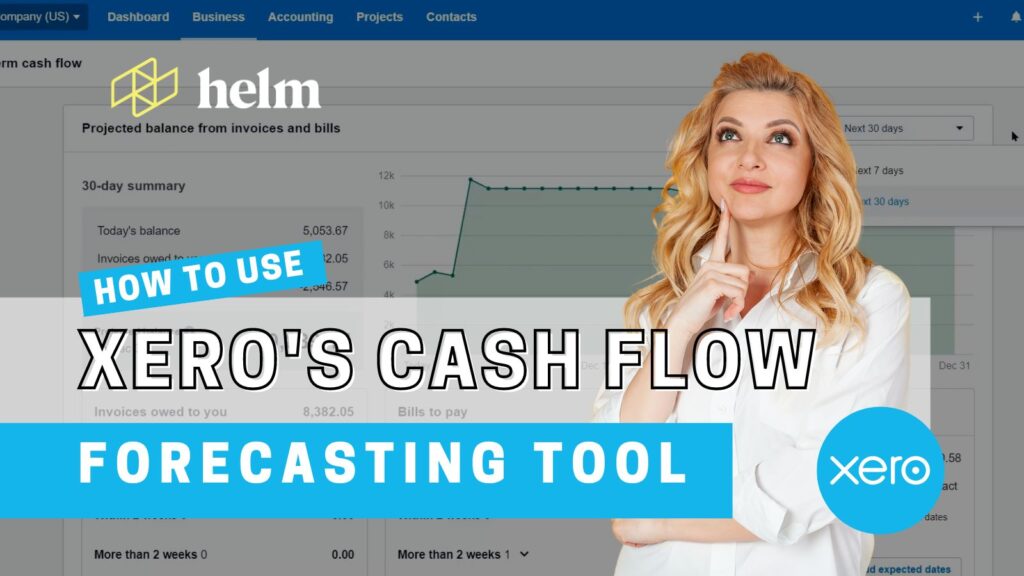In this guide we’ll show how you can use Xero’s built in short term cash flow forecasting tool to start making better business decisions.
Short term cash flow forecasting is a great tool for keeping track of upcoming payments and receivables. After reading this guide you’ll be able to use Xero’s built in tool, and decide whether it’s the right fit for your business.
Not sure if short or long-term forecasting is right for you? Read our guide Short vs Long-Term Cash Flow Forecasting.
Today’s Agenda:
Does Xero have a cash flow forecasting tool?
First up lets get some housekeeping out of the way and answer some common questions
Q: What is Xero?
A: Xero provides online accounting software for small business.
Q: Does Xero have a cash flow forecasting tool?
A: Yes! Xero has a built in tool allowing you to view a short term cash flow forecast.
Q: Do you have to pay to use it?
A: Cash flow forecasting is included as part of your subscription to Xero!
Q: What length of forecasting is available in Xero?
A: You can view a 1 week (7 day) and a 1 month (30 day) forecast.
With the basics out of the way let’s jump in and take a look at the tool!
How do I create a cash flow forecast in Xero?
First up login to your Xero account. When you log in you’ll see your dashboard:
-png.png)
From the dashboard to access the cash flow forecast look under the ‘Business” tab in the top left. Click on the first option: ‘Short-term cash flow’.
-png.png)
This will bring you to the cash flow page:
-png.png)
On this screen you’ll be able to see Xero has calculated your projected balance from invoices and bills for the next 7 or 30 days.
You can change the time period in the top right corner.
-png.png)
In the top right corner, you can also edit which bank account(s)are included in the projection.
-png.png)
With our bank accounts and time frame selected let’s take a look at the information you’ll find included in the report.
Starting in the top left you’ll find your 30-day (or 7-day) summary including your balance today, invoices owed to you this period, bills to be payed this period, and your projected cash position at the end of the selected time frame.
Note: To ensure your starting balance and cash flow report is accurate you’ll want to first make sure your bank accounts are fully reconciled.
-png.png)
To the right of this summary you’ll find a graphical representation of your balance for the time period.
-png.png)
Below these you’ll find a more detailed look at the invoices owed to you and bills to be paid.
Here you can see exactly what transactions need to be completed, and when. You can also choose to group transactions by date or contact.
-png.png)
To the right of these you’ll also find a section for suggested actions generated by Xero to help improve your forecast.
Xero will suggest things like adding expected due dates for overdue invoices to improve your cash flow forecast.
Any transactions not dated within the forecasting period will not be included in your cash flow projection.
Use your discretion and knowledge of the business when making any changes.
-png.png)
Should I use Xero’s cash flow forecasting tool?
Cash flow forecasting is a key part of managing your business, so if you aren’t doing any kind of cash flow forecasting Xero’s built in tool can be a great starting point!
Compared to other options available on the market, however, Xero’s tool is limiting in terms of features and flexibility
Advantages of Cash Flow Forecasting in Xero
The biggest advantages Xero’s tool has in that is built in to your accounting software meaning that you don’t have to search for, or learn another tool.
Another big plus is that it comes free with your Xero subscription, so there’s no additional cost to you!
Limitations of Cash Flow Forecasting in Xero
The first frustration with Xero’s cashflow forecast you’ll likely encounter is the limited time frame options.
Xero has options for a 7-day or 30-day forecast. While this is good for seeing immediate shortcomings, it isn’t very helpful for any sort of planning.
You’ll still be left in the dark for the coming months, and the year ahead. This can be especially problematic if your business has seasonal differences in cash flows.
Speaking of planning there’s also a lack of any sort of scenario planning. Frequently, when we create cash flow forecasts it’s to answer questions like:
- What happens if our biggest client pays late this month?
- Is it possible for us to delay a payment?
- Can my team afford to take on that big project next quarter?
- How is inflation going to affect my costs compared to this time last year?
- Can we afford to add staff to our team this year?
Without a way to test scenarios, paired with extremely short time horizons, Xero’s tool struggles to provide any answer to questions like these.
Ultimately, businesses looking for more substantial insights and a more rigorous cash flow report will likely not be satisfied with Xero’s built in tool.
The good news is through the Xero Marketplace you can find many tools and apps that are compatible with Xero – including Helm!
Helm vs. Xero cash flow forecasting
Helm includes a host of additional features to enhance your forecasting like:
- Automated 1-month, 3 month, 6-month and 1-year forecasting
- Data synch with Xero
- Unlimited Scenario Planning
- Accounts payable and accounts receivable management
- Financial health metric dashboard
- Unlimited users
- Access to support from cash flow experts
- & more!
